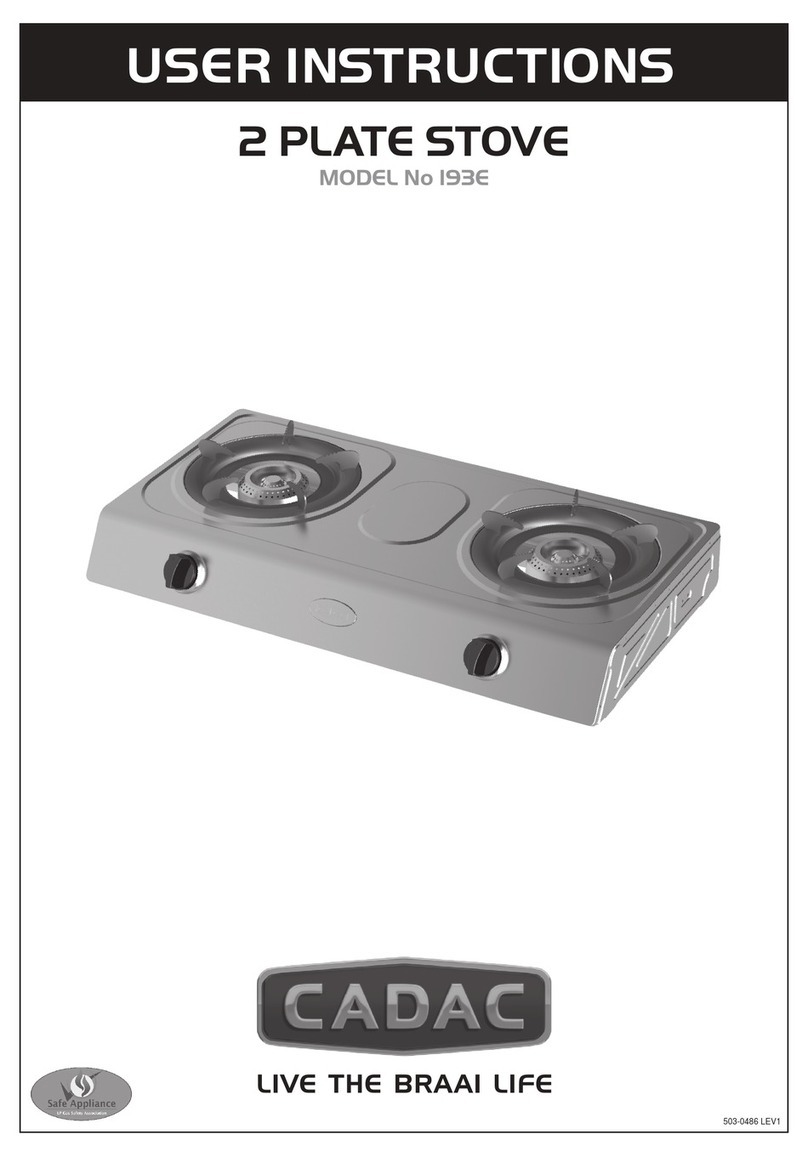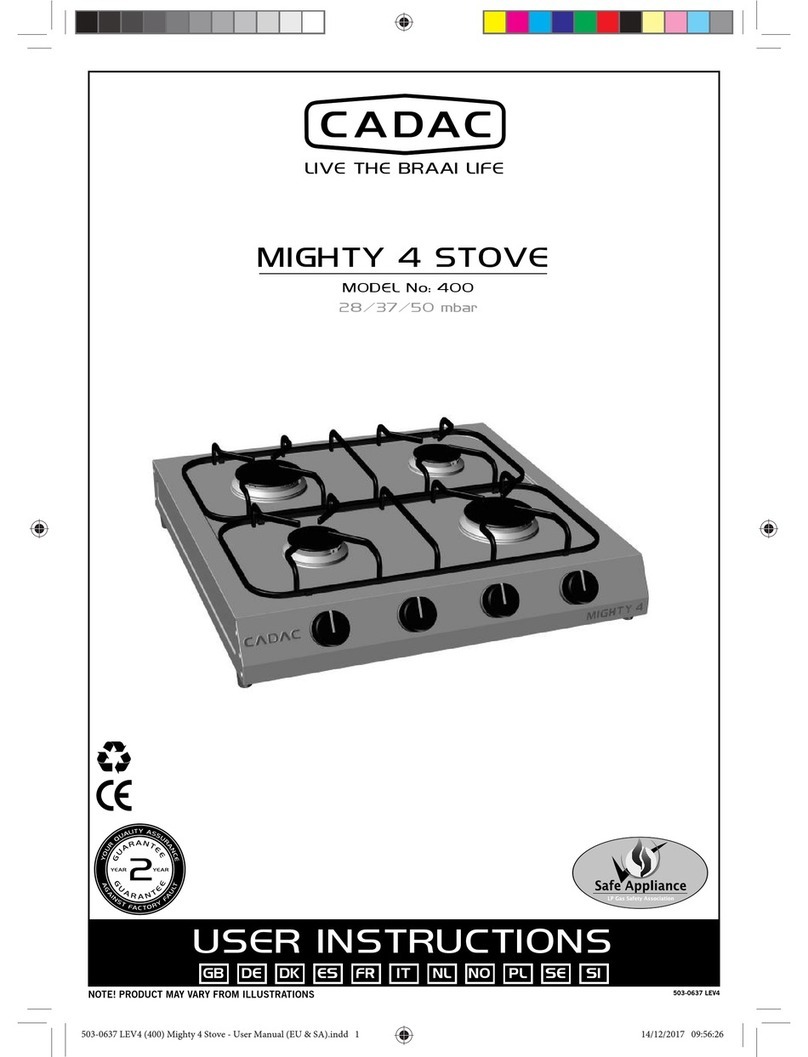
5. FITTINGAND CHANGING THE GAS CYLINDER
6. USINGTHEAPPLIANCE
WARNING: IF THE BURNER FAILS TO IGNITE WITHIN 10 SECONDS, TURN THE CONTROL KNOB OFF
(CLOCKWISE). WAIT THREE MINUTES BEFORE ATTEMPTING TO RE-LIGHT WITH
IGNITION SEQUENCE.
7. GENERALMAINTENANCE
8. TROUBLESHOOTING
9. CLEANING
Before connecting the appliance to a gas cylinder, ensure that the rubber seal on the regulator is in position and in good condition. Carry out this
check each
The appliance is designed for use with cooking vessels of not less than 150mm in diameter and not greater than 250mm in diameter.
This appliance does not require scheduled maintenance.
A normal flame is blue and may have a yellow tip. If the flame is completely yellow, it may be that the jet is not securely fitted. Re-tighten the jet
The pot stand is removed by lifting it from the stove top and can be washed in a detergent solution.
time you fit the appliance to a gas cylinder.
Blow out any dust from the cylinder opening to prevent possible blockage of the jet.
Ensure that the appliance valves are in the OFF position by turning the knobs fully clockwise to their stop (See Fig. 3).
Ensure that the gas cylinder is fitted or changed in a well ventilated location, preferably outdoors, away from any source of ignition, such as naked flames
and away from other people.
Make sure that the gas cylinder is kept upright at all times while screwing the connection to the cylinder, hand tighten until fully engaged.
Ensure that a complete gas seal has been made (check for the smell of gas around the connection joint). If there is a leak on your appliance (smell of gas),
take it outside immediately into a well ventilated flame free location where the leak may be detected and stopped. To check for leaks on your appliance,
do it outside using warm soapy water only, which is applied to the joints and connections of the appliance.A formation of bubbles will indicate the gas
leak.
Do not check for leaks with a naked flame.
If you cannot rectify the gas leak, do not use the appliance, contact your local CADAC stockist for assistance.
When changing a gas cylinder, close the cylinder valve (if fitted) and then the appliance valve. Make sure the flame is extinguished before unscrewing
the regulator. Re-fit the regulator to a full cylinder following the same precautions as described above.
The pot stands and aluminium grill plates can be used in any configuration (i.e. one pot stand and one grill, two grills or two pot stands).
After lighting, do not move the gas cylinder and the appliance around, as liquefied gas may enter the appliance from the gas cylinder, causing it to
flare (large yellow flames).
Always operate the appliance on a firm level surface with the gas cylinder in an upright position.
Turn the control knob clockwise to the 'OFF' position.
Turn the gas supply 'ON' at the cylinder.
Turn the control knob anti-clockwise until a hissing sound is heard, press the piezo button. This should ignite the burner.
If the burner does not stay alight, repeat as above.
To turn the stove 'OFF', turn the cylinder valve to the 'OFF' position and then turn the control knob on the appliance clockwise to the‘OFF' position.
To light the appliance, ignite a match or barbecue lighter, turn ON the appliance valve after connecting to and opening the cylinder valve, by turning
the control knob in an anti-clockwise direction. Light the appliance burner.
Use the control knob to adjust the flame intensity to the desired level by turning the knob clockwise to decrease the flame and anti-clockwise to
increase it (See Fig. 3).
After use, close valve on gas cylinder. When the flame has extinguished close the valve on the appliance by turning knob fully clockwise.
It is dangerous to use an appliance with a cracked or perished seal and / or tubing. Inspect both seals and tubing regularly and replace if they are
not in order, before using the appliance.
If the appliance was in use, it will be hot. Allow to cool sufficiently before attempting any maintenance.
The stove is fitted with jets to regulate the correct amount of gas.
Should the hole in the jet become blocked this may result in a small flame or no flame at all. Do not attempt to clean the jet with a pin or other such
device as this may damage the orifice, which could make the appliance unsafe.
Ensure that the cylinder valve is closed, and then disconnect the appliance from the gas cylinder.
Remove the self tapping screw which holds the venturi in place.
Move the burner assembly back slightly so as to expose the valve and the jet.
Unscrew the blocked jet with a suitable spanner and replace it with a new jet.
Do not over tighten as this may damage the jet. To re-assemble, reverse the above procedure.
Do not use pliers on the jet as this may damage the jet making it unusable or impossible to remove.
Fitting of a hose is described in Section 4.
to give a gas tight seal. An overfilled gas cylinder can also cause large yellow flames. The cylinder should be returned to filling station and checked
by weight.
Check that the inlet to the venturi is clear and free of obstructions.
If the flame power drops or the gas will not light, check that the gas cylinder still contains gas (shake to hear the noise made by the liquefied gas). If
there is still gas, the jet might have become blocked or partially blocked.
If you suspect a blocked jet, follow the instructions above.
To clean the stove body, simply wipe with a damp cloth using a little detergent, if necessary.
DO NOT IMMERSE IN WATER as this will allow water to get into the mixing tube causing the appliance to malfunction.
Do not use abrasive cleaners or scourers as this will cause permanent damage to the painted surface.
To avoid ignition failure, keep the burners clean.
Lighting the Appliance using the Piezo (Not Applicable to Model 186F & 187F)
Lighting the Appliance with a Match
Replacing a Blocked Jet
Replacement of Hose
GB




























